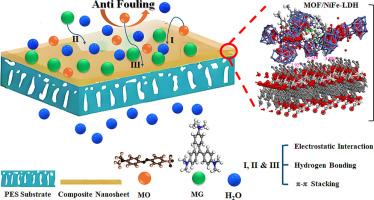ph响应MIL-101(Fe)/NiFe-LDH复合膜在废水处理中的高通量去除阳离子和阴离子染料
IF 9.8
1区 工程技术
Q1 ENGINEERING, CHEMICAL
引用次数: 0
摘要
合成染料具有毒性、诱变性和致癌性,对水生生态系统和人类健康构成严重威胁。膜过滤提供了一种节能的解决方案,但同时对阳离子和阴离子染料实现高选择性、渗透性和稳定性仍然具有挑战性。在这里,我们将MIL-101(Fe),一种高孔隙率的金属有机骨架(MOF),与nife层状双氢氧化物(LDH)纳米片集成在一起,设计了一种分层复合膜。MIL-101(Fe)基质提供了大表面积(~ 19.2 m2/g)和定制的孔结构,用于尺寸选择性吸附。同时,NiFe-LDH通过其ph可调的表面电荷(等电点= 3.16)增强静电相互作用。这种协同作用使甲基绿(MG, 88%)和甲基橙(MO, 91%)在超高水通量(>100 L·m−2·h−1·bar−1)下的去除效率优于传统膜(表S1)。该膜的pH响应选择性,由ζ电位反转驱动,允许有针对性地去除阳离子(例如,pH >; 3.16时的MG)和阴离子(例如,pH <; 3.16时的MO)染料。密度泛函理论(DFT)模拟表明,MIL-101吸附MG的过程是通过与苯连接剂的π-π堆积和LDH羟基的静电吸引进行的。相反,MO摄取涉及与LDH间层的阴离子交换。凭借优异的可回收性(5次循环后效率达80%)和防污性能(通量回收率达90%),本研究推进了可扩展污水处理的多功能膜的设计。本文章由计算机程序翻译,如有差异,请以英文原文为准。

pH-responsive MIL-101(Fe)/NiFe-LDH composite membranes for high-flux removal of cationic and anionic dyes in wastewater treatment
Synthetic dyes, known for their toxicity, mutagenicity, and carcinogenicity, pose severe threats to aquatic ecosystems and human health. Membrane filtration offers an energy-efficient solution, but achieving simultaneously high selectivity, permeability, and stability for both cationic and anionic dyes remain challenging. Here, we design a hierarchical composite membrane by integrating MIL-101(Fe), a high-porosity metal-organic framework (MOF), with NiFe-layered double hydroxide (LDH) nanosheets. The MIL-101(Fe) matrix provides a large surface area (∼19.2 m2/g) and tailored pore architecture for size-selective adsorption. At the same time, the NiFe-LDH enhances electrostatic interactions via its pH-tunable surface charge (isoelectric point = 3.16). This synergy enables exceptional removal efficiencies for methyl green (MG, 88 %) and methyl orange (MO, 91 %) at ultrahigh water flux (>100 L·m−2·h−1·bar−1), outperforming conventional membranes (Table S1). The membrane's pH-responsive selectivity, driven by zeta potential reversal, allows targeted removal of cationic (e.g., MG at pH > 3.16) and anionic (e.g., MO at pH < 3.16) dyes. Density functional theory (DFT) simulations reveal that MG adsorption occurs via π-π stacking with MIL-101's benzene linkers and electrostatic attraction to LDH hydroxyl groups. In contrast, MO uptake involves anion exchange with LDH interlayers. With excellent recyclability (>80 % efficiency after 5 cycles) and antifouling properties (flux recovery >90 %), this work advances the design of multifunctional membranes for scalable wastewater treatment.
求助全文
通过发布文献求助,成功后即可免费获取论文全文。
去求助
来源期刊

Desalination
工程技术-工程:化工
CiteScore
14.60
自引率
20.20%
发文量
619
审稿时长
41 days
期刊介绍:
Desalination is a scholarly journal that focuses on the field of desalination materials, processes, and associated technologies. It encompasses a wide range of disciplines and aims to publish exceptional papers in this area.
The journal invites submissions that explicitly revolve around water desalting and its applications to various sources such as seawater, groundwater, and wastewater. It particularly encourages research on diverse desalination methods including thermal, membrane, sorption, and hybrid processes.
By providing a platform for innovative studies, Desalination aims to advance the understanding and development of desalination technologies, promoting sustainable solutions for water scarcity challenges.
 求助内容:
求助内容: 应助结果提醒方式:
应助结果提醒方式:


